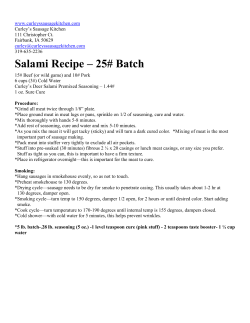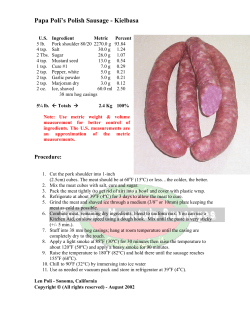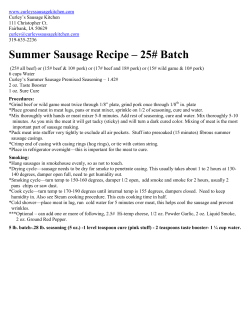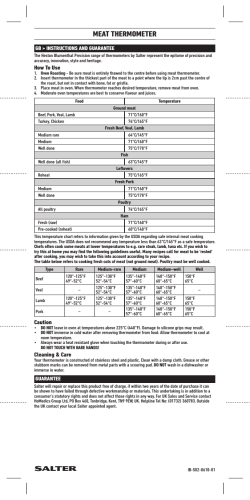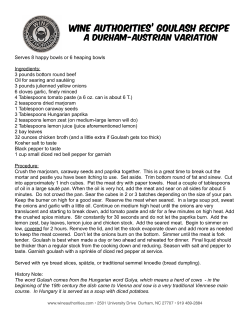
How to detect Course Fee First international Course
Why is Boar Taint a concern? Since 2010 The European Commission and representatives of the swine sector voluntarily agreed to abandon surgical castration of piglets before January 2018 (European Declaration on alternatives to surgical castration of pigs; SANCO 2010). Different alternatives are being discussed, and one of the most accepted is the production of entire male pigs which may accumulate boar taint. Raising boars? A risk or an opportunity? Raising entire male pigs has been related to animal welfare because it is considered a friendlier production system compared to the production of castrated pigs. However, some differences on meat quality can emerge (exudative meat, pale colour, leaner meat etc.) depending on several factors such as genetics, feeding regime and management that need to be well known. In addition, different strategies in the production system and the efficiency between castrates and entire males should be well understood as they are important economical markers. Why is important to detect Boar Taint? Despite the fact of knowing the different factors affecting the accumulation of boar taint compounds, a detection system at the abattoir or in the cutting plants is still needed. Boar taint in meat and meat products could be detected by grading the carcasses in the slaughterhouse or the raw meat in the meat processing industry. Thus, detection of boar taint on line and at line becomes crucial to decide the best application of meat and therefore, assure pork quality for the consumer. Targeted audience: IRTA organises the 1st International Training Course On Alternatives To Pig Castration, Detection Methods For Boar Taint And Meat Quality, addressed to professionals of the pig sector with the objective to answer the following questions: • What percentage of commercialised entire male carcasses and cuts accumulate boar taint? Is this percentage different from some years ago? Why? • Why surgical castration is currently questioned in Europe? • Which are the alternatives to surgical castration that Europe is considering? • Which are the potential markets and commercial applications for boar tainted meat? • Which percentage of consumers is susceptible to detect boar taint in fresh meat and meat products? • What can we expect from consumer preferences and willingness to pay for fresh pig meat? • Which are the social consequences derived from the new potential regulation (welfare, ethics etc.)? • How does the new potential regulation impact on purchasing decisions? • Which detection systems could be used to select boar carcasses with boar taint? • What is the Human Nose methodology? How can be applied in-line and at-line? � Quality and Food Safety Managers and technicians of the whole pork production chain (slaughterhouses, cutting plants, meat industry). Retail Sector. Sales & Marketing Staff. Veterinarians. First International Course Course Fee 1st and 2nd registration of the same company: 1.100 € 25% of discount on the 3rd (or more) registrations of the same company. 10% of discount to IRTA’s costumers with an R+D contract in the last 3 years. The course includes: 2 nights (24th and 25th of April) in a 4* star hotel in Girona centre Transport from and to the hotel Lunch and coffee breaks during the seminar Course material Social dinner Registration: http://goo.gl/370W8H Deadline for registrations 31st of March 2014 Payment should be made on the Organisers account. When you have filled in the on-line form, please send the payment form by e-mail to the Organising Secretariat: [email protected] Payment by bank transfer must be received and processed before the event, to the following account number: Account holder: INSTITUT DE RECERCA I TECNOLOGIA AGROALIMENTÀRIES Bank name: CAIXABANK Country: SPAIN Address: Avinguda les voltes, 2. E-17100 La Bisbal d’Empordà. IBAN: (ES06) 2100 0031 2702 00352939 SWIFT/BIC: CAIXESBBXXX Please, indicate “Boar Taint Course” and full name of the attendant. How to detect Boar Taint and preserve meat quality Alternatives to castration: an European challenge for 2018 24th and 25th of April 2014 For more information about the course contact: Dr. Eva Ogué +34 972 63 00 52 ext. 1486 [email protected] IRTA Monells Girona, Spain IRTA Monells Finca Camps i Armet s/n 17121, Monells Girona, Spain GPS: +41° 58’ 34.02”, +2° 59’ 51.35” T (+34) 972 63 00 52 Why is Boar Taint a concern? Since 2010 The European Commission and representatives of the swine sector voluntarily agreed to abandon surgical castration of piglets before January 2018 (European Declaration on alternatives to surgical castration of pigs; SANCO 2010). Different alternatives are being discussed, and one of the most accepted is the production of entire male pigs which may accumulate boar taint. Raising boars? A risk or an opportunity? Raising entire male pigs has been related to animal welfare because it is considered a friendlier production system compared to the production of castrated pigs. However, some differences on meat quality can emerge (exudative meat, pale colour, leaner meat etc.) depending on several factors such as genetics, feeding regime and management that need to be well known. In addition, different strategies in the production system and the efficiency between castrates and entire males should be well understood as they are important economical markers. Why is important to detect Boar Taint? Despite the fact of knowing the different factors affecting the accumulation of boar taint compounds, a detection system at the abattoir or in the cutting plants is still needed. Boar taint in meat and meat products could be detected by grading the carcasses in the slaughterhouse or the raw meat in the meat processing industry. Thus, detection of boar taint on line and at line becomes crucial to decide the best application of meat and therefore, assure pork quality for the consumer. Targeted audience: IRTA organises the 1st International Training Course On Alternatives To Pig Castration, Detection Methods For Boar Taint And Meat Quality, addressed to professionals of the pig sector with the objective to answer the following questions: • What percentage of commercialised entire male carcasses and cuts accumulate boar taint? Is this percentage different from some years ago? Why? • Why surgical castration is currently questioned in Europe? • Which are the alternatives to surgical castration that Europe is considering? • Which are the potential markets and commercial applications for boar tainted meat? • Which percentage of consumers is susceptible to detect boar taint in fresh meat and meat products? • What can we expect from consumer preferences and willingness to pay for fresh pig meat? • Which are the social consequences derived from the new potential regulation (welfare, ethics etc.)? • How does the new potential regulation impact on purchasing decisions? • Which detection systems could be used to select boar carcasses with boar taint? • What is the Human Nose methodology? How can be applied in-line and at-line? � Quality and Food Safety Managers and technicians of the whole pork production chain (slaughterhouses, cutting plants, meat industry). Retail Sector. Sales & Marketing Staff. Veterinarians. First International Course Course Fee 1st and 2nd registration of the same company: 1.100 € 25% of discount on the 3rd (or more) registrations of the same company. 10% of discount to IRTA’s costumers with an R+D contract in the last 3 years. The course includes: 2 nights (24th and 25th of April) in a 4* star hotel in Girona centre Transport from and to the hotel Lunch and coffee breaks during the seminar Course material Social dinner Registration: http://goo.gl/370W8H Deadline for registrations 31st of March 2014 Payment should be made on the Organisers account. When you have filled in the on-line form, please send the payment form by e-mail to the Organising Secretariat: [email protected] Payment by bank transfer must be received and processed before the event, to the following account number: Account holder: INSTITUT DE RECERCA I TECNOLOGIA AGROALIMENTÀRIES Bank name: CAIXABANK Country: SPAIN Address: Avinguda les voltes, 2. E-17100 La Bisbal d’Empordà. IBAN: (ES06) 2100 0031 2702 00352939 SWIFT/BIC: CAIXESBBXXX Please, indicate “Boar Taint Course” and full name of the attendant. How to detect Boar Taint and preserve meat quality Alternatives to castration: an European challenge for 2018 24th and 25th of April 2014 For more information about the course contact: Dr. Eva Ogué +34 972 63 00 52 ext. 1486 [email protected] IRTA Monells Girona, Spain IRTA Monells Finca Camps i Armet s/n 17121, Monells Girona, Spain GPS: +41° 58’ 34.02”, +2° 59’ 51.35” T (+34) 972 63 00 52 Program Day 24 April 9.30 - 10.00 Registration and welcoming 10.00 - 11.30 MODULE 1 The boar taint: responsible compounds and factors that influence in its accumulation 1.1 Responsible compounds for the boar taint 1.2 Effects of breeding and genetics 1.3 Effects of feeding, weight, age and animal management 1.4 Prevalence of boar taint in carcasses. 1.5 The economic differences in the production of entire males and castrated pigs 11.30 - 12.00 ø Coffee Break 12.00 - 13.30 MODULE 2 Castration in Europe: current situation 2.1 Current European legislation in castration and the new European declaration. 2.2 Criteria for welfare and quality 2.3 Some exceptions 2.4 Alternatives to castration 13.30 - 14.30 ƒ Lunch 14.30 - 16.00 MODULE 3 Productive data, carcass, meat quality and consumer preferences 3.1 Entire vs castrated, females and immunocastrated males. 3.2 Sensitivity (anosmia) to androstenone and skatole. 16:00 – 16:30 ø Coffee Break 16:30 – 18:00 MODULE 3 Productive data, carcass, meat quality and consumer preferences 3.3 Consumer studies and factors that affect purchasing behaviour for fresh pork. Results from last European studies. 20.30 ƒ Course Dinner Program Day 25 April 9.30 - 11.00 MODULE 4 Practical session: Detection methods 4.1 Analytical methods for androstenone and skatole 4.2 Methods to determine sensitivity/anosmia to androstenone. Practical session: triangular test for detection of anosmia for androstenone and skatole. 11.00 - 11.30 ø Coffee Break 11.30 - 13.00 MODULE 4 Practical session: Detection methods 4.5 At-line boar taint detection in meat and meat products: “Human Nose” methodology. 4.6. On-line boar taint detection in meat and meat products: “Human Nose” methodology. 4.7. How do we train assessors for boar taint classification? Step by step guide. 13.00 - 14.00 ƒ Lunch 14.00 - 15.00 MODULE 4 Practical session: Detection methods 4.8 New methodologies for boar taint detection. 4.9 Sensory analyses of meat from entire male pigs. Practical session: odour and flavour 15.00 End of the Course Lecturers Dr. Àngels Oliver Dr. Nuria Panella Head of the IRTA Product Quality Department. She has more than 55 scientific papers published and has given lectures and courses in universities, workshops and conferences inside and outside Europe. Her main research area is the quality of meat from a technological, nutritional and sensorial (boar taint - consumer studies) point of view, including its relationship with genetics and sustainability. She has participated in European and International projects, either as coordinator, Work Package leader or member of the Steering Committee and was deputy editor of the Animal Scientific Journal. Between 2010 and 2013 she has been chair of the EAAP working group “Production and utilisation of meat from entire male pigs”. She has been working extensively in research projects with the European pork sector. Junior scientist of the IRTA Product Quality Department. She has been involved in several national and European founded projects, either as a co-researcher or as a Work Package leader (Young Train project, PIGCAS, ALCASDE). She has also large experience in research projects in collaborations with companies and producer associations. She is currently in the management team of a national project titled “Potential market and meat quality from entire male pigs, facing new EU policies towards the banning of castration”. Additionally, she is working in the development of the “Human nose” methodology in Spanish abattoirs, cutting plants and meat industries. She has coordinated the last Workshop on “Detection Methods for boar taint” under the Boarcheck project and the last meeting of the EAAP working group on the production and utilization of entire male pigs, both held at IRTA in December 2013. Program Day 24 April 9.30 - 10.00 Registration and welcoming 10.00 - 11.30 MODULE 1 The boar taint: responsible compounds and factors that influence in its accumulation 1.1 Responsible compounds for the boar taint 1.2 Effects of breeding and genetics 1.3 Effects of feeding, weight, age and animal management 1.4 Prevalence of boar taint in carcasses. 1.5 The economic differences in the production of entire males and castrated pigs 11.30 - 12.00 ø Coffee Break 12.00 - 13.30 MODULE 2 Castration in Europe: current situation 2.1 Current European legislation in castration and the new European declaration. 2.2 Criteria for welfare and quality 2.3 Some exceptions 2.4 Alternatives to castration 13.30 - 14.30 ƒ Lunch 14.30 - 16.00 MODULE 3 Productive data, carcass, meat quality and consumer preferences 3.1 Entire vs castrated, females and immunocastrated males. 3.2 Sensitivity (anosmia) to androstenone and skatole. 16:00 – 16:30 ø Coffee Break 16:30 – 18:00 MODULE 3 Productive data, carcass, meat quality and consumer preferences 3.3 Consumer studies and factors that affect purchasing behaviour for fresh pork. Results from last European studies. 20.30 ƒ Course Dinner Program Day 25 April 9.30 - 11.00 MODULE 4 Practical session: Detection methods 4.1 Analytical methods for androstenone and skatole 4.2 Methods to determine sensitivity/anosmia to androstenone. Practical session: triangular test for detection of anosmia for androstenone and skatole. 11.00 - 11.30 ø Coffee Break 11.30 - 13.00 MODULE 4 Practical session: Detection methods 4.5 At-line boar taint detection in meat and meat products: “Human Nose” methodology. 4.6. On-line boar taint detection in meat and meat products: “Human Nose” methodology. 4.7. How do we train assessors for boar taint classification? Step by step guide. 13.00 - 14.00 ƒ Lunch 14.00 - 15.00 MODULE 4 Practical session: Detection methods 4.8 New methodologies for boar taint detection. 4.9 Sensory analyses of meat from entire male pigs. Practical session: odour and flavour 15.00 End of the Course Lecturers Dr. Àngels Oliver Dr. Nuria Panella Head of the IRTA Product Quality Department. She has more than 55 scientific papers published and has given lectures and courses in universities, workshops and conferences inside and outside Europe. Her main research area is the quality of meat from a technological, nutritional and sensorial (boar taint - consumer studies) point of view, including its relationship with genetics and sustainability. She has participated in European and International projects, either as coordinator, Work Package leader or member of the Steering Committee and was deputy editor of the Animal Scientific Journal. Between 2010 and 2013 she has been chair of the EAAP working group “Production and utilisation of meat from entire male pigs”. She has been working extensively in research projects with the European pork sector. Junior scientist of the IRTA Product Quality Department. She has been involved in several national and European founded projects, either as a co-researcher or as a Work Package leader (Young Train project, PIGCAS, ALCASDE). She has also large experience in research projects in collaborations with companies and producer associations. She is currently in the management team of a national project titled “Potential market and meat quality from entire male pigs, facing new EU policies towards the banning of castration”. Additionally, she is working in the development of the “Human nose” methodology in Spanish abattoirs, cutting plants and meat industries. She has coordinated the last Workshop on “Detection Methods for boar taint” under the Boarcheck project and the last meeting of the EAAP working group on the production and utilization of entire male pigs, both held at IRTA in December 2013. Program Day 24 April 9.30 - 10.00 Registration and welcoming 10.00 - 11.30 MODULE 1 The boar taint: responsible compounds and factors that influence in its accumulation 1.1 Responsible compounds for the boar taint 1.2 Effects of breeding and genetics 1.3 Effects of feeding, weight, age and animal management 1.4 Prevalence of boar taint in carcasses. 1.5 The economic differences in the production of entire males and castrated pigs 11.30 - 12.00 ø Coffee Break 12.00 - 13.30 MODULE 2 Castration in Europe: current situation 2.1 Current European legislation in castration and the new European declaration. 2.2 Criteria for welfare and quality 2.3 Some exceptions 2.4 Alternatives to castration 13.30 - 14.30 ƒ Lunch 14.30 - 16.00 MODULE 3 Productive data, carcass, meat quality and consumer preferences 3.1 Entire vs castrated, females and immunocastrated males. 3.2 Sensitivity (anosmia) to androstenone and skatole. 16:00 – 16:30 ø Coffee Break 16:30 – 18:00 MODULE 3 Productive data, carcass, meat quality and consumer preferences 3.3 Consumer studies and factors that affect purchasing behaviour for fresh pork. Results from last European studies. 20.30 ƒ Course Dinner Program Day 25 April 9.30 - 11.00 MODULE 4 Practical session: Detection methods 4.1 Analytical methods for androstenone and skatole 4.2 Methods to determine sensitivity/anosmia to androstenone. Practical session: triangular test for detection of anosmia for androstenone and skatole. 11.00 - 11.30 ø Coffee Break 11.30 - 13.00 MODULE 4 Practical session: Detection methods 4.5 At-line boar taint detection in meat and meat products: “Human Nose” methodology. 4.6. On-line boar taint detection in meat and meat products: “Human Nose” methodology. 4.7. How do we train assessors for boar taint classification? Step by step guide. 13.00 - 14.00 ƒ Lunch 14.00 - 15.00 MODULE 4 Practical session: Detection methods 4.8 New methodologies for boar taint detection. 4.9 Sensory analyses of meat from entire male pigs. Practical session: odour and flavour 15.00 End of the Course Lecturers Dr. Àngels Oliver Dr. Nuria Panella Head of the IRTA Product Quality Department. She has more than 55 scientific papers published and has given lectures and courses in universities, workshops and conferences inside and outside Europe. Her main research area is the quality of meat from a technological, nutritional and sensorial (boar taint - consumer studies) point of view, including its relationship with genetics and sustainability. She has participated in European and International projects, either as coordinator, Work Package leader or member of the Steering Committee and was deputy editor of the Animal Scientific Journal. Between 2010 and 2013 she has been chair of the EAAP working group “Production and utilisation of meat from entire male pigs”. She has been working extensively in research projects with the European pork sector. Junior scientist of the IRTA Product Quality Department. She has been involved in several national and European founded projects, either as a co-researcher or as a Work Package leader (Young Train project, PIGCAS, ALCASDE). She has also large experience in research projects in collaborations with companies and producer associations. She is currently in the management team of a national project titled “Potential market and meat quality from entire male pigs, facing new EU policies towards the banning of castration”. Additionally, she is working in the development of the “Human nose” methodology in Spanish abattoirs, cutting plants and meat industries. She has coordinated the last Workshop on “Detection Methods for boar taint” under the Boarcheck project and the last meeting of the EAAP working group on the production and utilization of entire male pigs, both held at IRTA in December 2013. Why is Boar Taint a concern? Since 2010 The European Commission and representatives of the swine sector voluntarily agreed to abandon surgical castration of piglets before January 2018 (European Declaration on alternatives to surgical castration of pigs; SANCO 2010). Different alternatives are being discussed, and one of the most accepted is the production of entire male pigs which may accumulate boar taint. Raising boars? A risk or an opportunity? Raising entire male pigs has been related to animal welfare because it is considered a friendlier production system compared to the production of castrated pigs. However, some differences on meat quality can emerge (exudative meat, pale colour, leaner meat etc.) depending on several factors such as genetics, feeding regime and management that need to be well known. In addition, different strategies in the production system and the efficiency between castrates and entire males should be well understood as they are important economical markers. Why is important to detect Boar Taint? Despite the fact of knowing the different factors affecting the accumulation of boar taint compounds, a detection system at the abattoir or in the cutting plants is still needed. Boar taint in meat and meat products could be detected by grading the carcasses in the slaughterhouse or the raw meat in the meat processing industry. Thus, detection of boar taint on line and at line becomes crucial to decide the best application of meat and therefore, assure pork quality for the consumer. Targeted audience: IRTA organises the 1st International Training Course On Alternatives To Pig Castration, Detection Methods For Boar Taint And Meat Quality, addressed to professionals of the pig sector with the objective to answer the following questions: • What percentage of commercialised entire male carcasses and cuts accumulate boar taint? Is this percentage different from some years ago? Why? • Why surgical castration is currently questioned in Europe? • Which are the alternatives to surgical castration that Europe is considering? • Which are the potential markets and commercial applications for boar tainted meat? • Which percentage of consumers is susceptible to detect boar taint in fresh meat and meat products? • What can we expect from consumer preferences and willingness to pay for fresh pig meat? • Which are the social consequences derived from the new potential regulation (welfare, ethics etc.)? • How does the new potential regulation impact on purchasing decisions? • Which detection systems could be used to select boar carcasses with boar taint? • What is the Human Nose methodology? How can be applied in-line and at-line? � Quality and Food Safety Managers and technicians of the whole pork production chain (slaughterhouses, cutting plants, meat industry). Retail Sector. Sales & Marketing Staff. Veterinarians. First International Course Course Fee 1st and 2nd registration of the same company: 1.100 € 25% of discount on the 3rd (or more) registrations of the same company. 10% of discount to IRTA’s costumers with an R+D contract in the last 3 years. The course includes: 2 nights (24th and 25th of April) in a 4* star hotel in Girona centre Transport from and to the hotel Lunch and coffee breaks during the seminar Course material Social dinner Registration (click on the link below): http://goo.gl/370W8H Deadline for registrations 31st of March 2014 Payment should be made on the Organisers account. When you have filled in the on-line form, please send the payment form by e-mail to the Organising Secretariat: [email protected] Payment by bank transfer must be received and processed before the event, to the following account number: Account holder: INSTITUT DE RECERCA I TECNOLOGIA AGROALIMENTÀRIES Bank name: CAIXABANK Country: SPAIN Address: Avinguda les voltes, 2. E-17100 La Bisbal d’Empordà. IBAN: (ES06) 2100 0031 2702 00352939 SWIFT/BIC: CAIXESBBXXX Please, indicate “Boar Taint Course” and full name of the attendant. How to detect Boar Taint and preserve meat quality Alternatives to castration: an European challenge for 2018 24th and 25th of April 2014 For more information about the course contact: Dr. Eva Ogué +34 972 63 00 52 ext. 1486 [email protected] IRTA Monells Girona, Spain IRTA Monells Finca Camps i Armet s/n 17121, Monells Girona, Spain GPS: +41° 58’ 34.02”, +2° 59’ 51.35” T (+34) 972 63 00 52
© Copyright 2026


